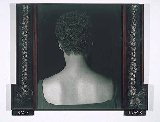5. The Body in Art and Philosophy
Feminist perspectives in aesthetics first arose in the 1970s from a combination of political activism in the contemporary art world and critiques of the historical traditions of philosophy and of the arts. They have developed in conjunction with the postmodern debates about culture and society that take place in many fields in the social sciences and humanities. These debates often begin with an assessment of the western philosophical legacy, a legacy that is nowhere more challenged than in the art world itself. Therefore, the significance of many contemporary art movements, including feminist and postfeminist work, is dramatized and clarified by understanding the traditional values and theories that they address and challenge.

The richest historical target for feminist critiques of philosophies of art has been directed at the concept of fine art, which refers to art that is created chiefly for aesthetic enjoyment. It includes at its core painting, music, literature, and sculpture, and it excludes crafts, popular art, and entertainment. Closely related to the concept of fine art are ideas about the creative genius of the artist, who is often conceived as possessing a unique vision expressed in art works. It was the fine art tradition of painting that art historian Linda Nochlin had in mind in 1971 when she asked her famous question, “Why have there been no great women artists?” (Nochlin 1971/1988). Since the modifier “fine” already contains profound implications for the gender of artists, some background of older history of ideas about art and artists is first needed in order to understand the variety of answers that can be provided to that question. This inquiry also positions us to understand the media, subject matter, and styles that contemporary feminist artists and art theorists have advanced. What is more, an inquiry into the ancient roots of philosophy of art discloses a tenacious value structure that has gendered significance, one that persists to this day.
The term “art” has not always served as shorthand for the fine arts. Like most of the terms that refer to major conceptual anchors of the western intellectual tradition, its origins may be traced to classical antiquity. The Greek term that we now usually translate “art” is techne, a term that is equally well translated “skill,” and that in its broadest sense was used to distinguish products of human endeavor from objects of nature. The types of techne that most resemble our modern concept of art are those that are “mimetic” or imitative, that is, that reproduce the look of an object or that express an idea in narrative or drama. Sculpture imitates the human form, for instance; music imitates sounds of nature and voices or — more abstractly — human emotions. Drama and epic poetry imitate lived events. That art's nature is to be mimetic was widely assumed for centuries, and most commentators, including Aristotle, extolled the ability of the mimetic artist to capture with beauty and skill some truth about life and the world. The Roman historian Pliny the Elder recorded the acclaim of painters who were able to render their subjects in line and color so accurately that they were indistinguishable from their appearance in nature.

Probably the earliest philosophical discussion of art in the Greek tradition occurs in Plato's Republic. Unlike most of his contemporaries, Plato regarded mimesis as dangerous. The Republic is an extended investigation of the nature of justice, in the course of which Socrates and his friends envision an ideal society that strictly censors and controls art forms such as drama, music, painting, and sculpture. According to Plato's metaphysics, the abstract world of the Forms possesses a greater degree of reality than their instances in the physical world; and hence the more direct the apprehension of Forms, the closer a human mind can approach Truth. Imitations such as paintings mimic the mere appearance of physical objects, becoming (as he puts it in Republic X) three times removed from reality and the truth. Mimesis substitutes illusion for truth, and it does so in seductively pleasurable ways. What is more, arts such as tragic poetry rivet attention by engaging powerful emotions such as fear, enervating the virtues of a courageous person but paradoxically pleasing at the same time. According to Plato's analysis of the human psyche, the nonrational elements of the soul are powerful forces that might divert the intellect from the cooler apprehension of wisdom; thus the pleasures that mimetic art delivers are sufficiently risky that art requires careful curb in a well-governed society.
Plato's denigration of mimesis does not seem immediately to have anything to do with gender, although his influential system has important indirect implications that are rife with gendered significance. In his preference for the philosophical quest to attain knowledge of the Forms over indulgence in the pleasures of mimesis, for example, one can see a hierarchy of values that rank the eternal, abstract, intellectual world of ideal forms over the transient, particular, sensuous world of physical objects. This hierarchy supports the dualism between mind and body that is deeply correlated with gender asymmetry, and that is a fundamental target of critique in virtually all feminist analyses. Feminist philosophers take note of certain concepts that appear in “binary” combinations: mind-body; universal-particular; reason-emotion, sense, and appetite; and so forth — including male-female. These are not merely correlative pairs, they are ranked pairs in which the first item is taken to be naturally superior to the second (Gatens 1991, p. 92). Universality is considered superior to particularity because it provides more general knowledge, for example; reason is superior to emotion because it is supposedly a more reliable faculty. Both preferences represent a partiality for “objectivity” over “subjectivity,” concepts that have an especially complicated significance in aesthetics. What is more, the sorts of pleasures that mimesis arouses are emotional and appetitive, appealing more to the body than to the intellect. Therefore we can find in Plato's peculiar assessment of mimetic arts an elevation of intellect and abstraction over emotion and particularity. While not explicitly invoked, gender is present in assumptions of this discussion, because “male” and “female” (sometimes conflated with “masculine” and “feminine,” though the terms are not synonymous) are root members of the pairs of opposites that have been present in western philosophy since Pythagoras. While there are no direct references to women creators in the Republic, this philosophy of art partakes of gendered concepts at is very core. The implications of such concepts for artists evolve into explicit form with the genesis of the modern category of fine art and its creators.

Scholars disagree about how to date the rise of the special category of arts designated “fine arts” or “beaux arts.” Some claim that the concept begins to emerge in the Renaissance, while others argue that it is not until the eighteenth century that fine arts really firm up as a distinct classification (Kristeller 1952-3; Shiner 2000). At this time the idea that art is essentially mimetic is no longer so strong, and it gradually gives way to a romantic concept of art as self-expression. The eighteenth century is also the period that sees a growth in literature comparing arts to one another according to shared principles, and of theories about a particular kind of pleasure taken in objects of nature and art that becomes known as “aesthetic” enjoyment.
The focus on fine art singles out the purely aesthetic values of works of art and positions them so centrally that the very concept of art is narrowed. Art that is appreciated for its beauty or other aesthetic virtues is distinct from the sorts of arts that produce items for practical use, such as furniture, cushions, or utensils. The latter came to be designated “crafts,” and while their usefulness and skill-requirements were recognized, the making of a craft object was considered decidedly less of an original achievement than the creation of a work of fine art. Artistic creativity increasingly came to be regarded as a kind of personal expression that externalizes the vision of the individual artist in a work of autonomous value; craft, by contrast, aims at some practical use.

The significance of the fine art-craft distinction for the assessment of women's creative production is substantial. While there are many objects that are excluded from the category of fine whose makers are male, those objects of domestic use whose creation was predominantly the occupation of women were all marginalized by this category and its attendant values (Parker and Pollock 1981). Thereby the traditional domestic arts were removed from the history of art proper. This historical change suggests one reason that painting, for example, has had so few “great” female practitioners: historically women's creative efforts were likely to be directed to the production of domestic wares; when these were shunted into the category of “craft,” women's presence in the genre of visual arts shrunk radically.








